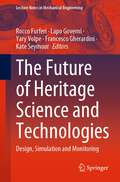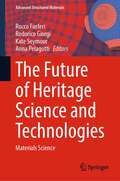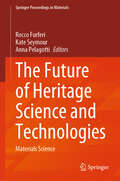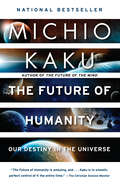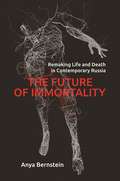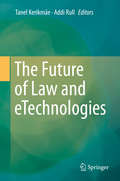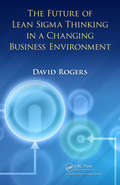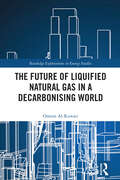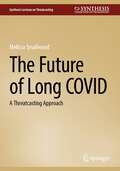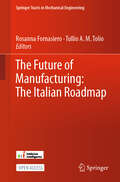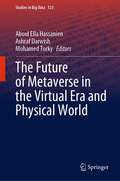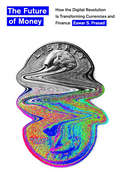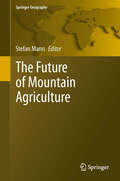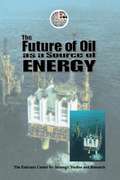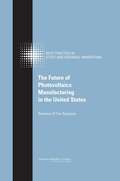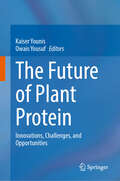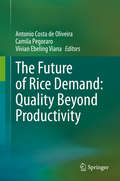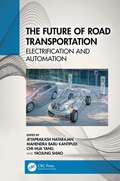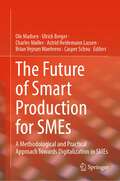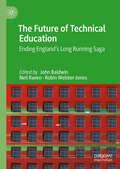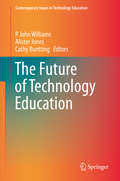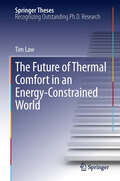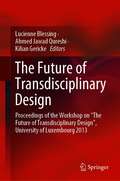- Table View
- List View
The Future of Heritage Science and Technologies: Design, Simulation and Monitoring (Lecture Notes in Mechanical Engineering)
by Francesco Gherardini Rocco Furferi Lapo Governi Yary Volpe Kate SeymourThis book gathers a selection of contributions dealing with the application of mechanical engineering for preserving and managing cultural heritage. It covers advanced techniques for 3D survey, modeling and simulation, reconstruction, data management as well as advanced diagnostics and testing methods. It highlights strategies to foster sustainability, inclusivity, energy saving and waste reuse in preventive conservation of historical buildings and sculptures, and large heritage sites. Based on contributions presented at the 3rd Florence Heri-Tech International Conference, held on May, 16-18, 2022, in Firenze, Italy, this book offers a timely source of information concerning engineering methods in heritage for both researchers and professionals in the field.
The Future of Heritage Science and Technologies: Materials Science (Advanced Structured Materials #179)
by Rodorico Giorgi Rocco Furferi Kate Seymour Anna PelagottiThis book presents selected work from the Florence Heri-Tech, a conference focused on the use of innovative technologies and methods for analyzing, managing, and preserving cultural heritage. This book presents chapters on the chemical and physical advancement in the development of new materials and methods for the conservation and restoration of cultural heritage. It also covers trends in conservation and restoration technology: biotechnology, nanotechnology, tailored materials, and physical technologies. The reader also finds information on methods and instruments for the conservation diagnosis and treatments.
The Future of Heritage Science and Technologies: Materials Science (Springer Proceedings in Materials #70)
by Rocco Furferi Kate Seymour Anna PelagottiThis book features selected contributions from Florence Heri-Tech 2024, showcasing cutting-edge technologies for the analysis, conservation, and restoration of cultural heritage. It explores advancements in materials science, including nanotechnology and plasma-based restoration, as well as innovative diagnostic methods. The book provides insights into biotechnology, tailored materials, and novel physical techniques, offering a comprehensive overview of emerging trends in heritage preservation.
The Future of Humanity: Terraforming Mars, Interstellar Travel, Immortality, and Our Destiny Beyond Earth
by Michio KakuNEW YORK TIMES BESTSELLER • The national bestselling author of The God Equation traverses the frontiers of astrophysics, artificial intelligence, and technology to offer a stunning vision of man's future in space, from settling Mars to traveling to distant galaxies. &“Amazing … Kaku is in smooth perfect control of it the entire time.&” —The Christian Science MonitorWe are entering a new Golden Age of space exploration. With irrepressible enthusiasm and a deep understanding of the cutting-edge research in space travel, world-renowned physicist and futurist Dr. Michio Kaku presents a compelling vision of how humanity may develop a sustainable civilization in outer space. He reveals the developments in robotics, nanotechnology, and biotechnology that may allow us to terraform and build habitable cities on Mars and beyond. He then journeys out of our solar system and discusses how new technologies such as nanoships, laser sails, and fusion rockets may actually make interstellar travel a possibility. We travel beyond our galaxy, and even beyond our universe, as Kaku investigates some of the hottest topics in science today, including warp drive, wormholes, hyperspace, parallel universes, and the multiverse. Ultimately, he shows us how humans may someday achieve a form of immortality and be able to leave our bodies entirely, laser porting to new havens in space.
The Future of Immortality: Remaking Life and Death in Contemporary Russia (Princeton Studies in Culture and Technology #23)
by Anya BernsteinA gripping account of the Russian visionaries who are pursuing human immortalityAs long as we have known death, we have dreamed of life without end. In The Future of Immortality, Anya Bernstein explores the contemporary Russian communities of visionaries and utopians who are pressing at the very limits of the human.The Future of Immortality profiles a diverse cast of characters, from the owners of a small cryonics outfit to scientists inaugurating the field of biogerontology, from grassroots neurotech enthusiasts to believers in the Cosmist ideas of the Russian Orthodox thinker Nikolai Fedorov. Bernstein puts their debates and polemics in the context of a long history of immortalist thought in Russia, with global implications that reach to Silicon Valley and beyond. If aging is a curable disease, do we have a moral obligation to end the suffering it causes? Could immortality be the foundation of a truly liberated utopian society extending beyond the confines of the earth—something that Russians, historically, have pondered more than most? If life without end requires radical genetic modification or separating consciousness from our biological selves, how does that affect what it means to be human?As vividly written as any novel, The Future of Immortality is a fascinating account of techno-scientific and religious futurism—and the ways in which it hopes to transform our very being.
The Future of Law and eTechnologies
by Tanel Kerikmäe Addi RullThis book presents groundbreaking discussions on e-residency,cryptocurrencies, scams, smart contracts, 3D printing, software agents, digitalevidence and e-governance at the intersection of law, legal policies and moderntechnologies. The reader benefits from cutting-edge analyses that offer ideasand solutions to some of the most pressing issues caused by e-technologies. This collection is a useful tool for law and IT practitioners and aninspiring source for interdisciplinary research. Besides serving as a practicalguideline, this book also reflects theoretical dimensions of futureperspectives, as new technologies are not meant to change common values but toaccommodate them.
The Future of Lean Sigma Thinking in a Changing Business Environment
by David RogersOf the 100 companies named to Fortune magazine’s list of the world’s largest companies in 1956, only 29 of those companies remain on that list. Many lost their way because they failed to recognize the changes taking place, or were too big to react quickly enough to shifting market conditions. Supplying Lean practitioners with a formal process for keeping up with technological advancements and shifting business requirements, The Future of Lean Sigma Thinking in a Changing Business Environment provides the tools to survive and prosper through the current business environment. It introduces cutting-edge business solutions from the fields of chemical engineering, aircraft production, and business psychology, and explains how to integrate these concepts with proven Lean principles. The book begins by providing a foundation in essential Lean concepts, including Deming and Juran, Six Sigma, Total Quality Management, the Toyota Production System, and New Six Sigma. Next, it reports on the latest advances in process understanding. By analyzing changing attitudes within the system, it illustrates how new products are being developed using updated Lean thinking. In addition, it provides examples that demonstrate the impact of e-commerce on Lean production systems. Incorporating the green agenda to Lean thinking, the text supplies the insight to safely navigate your company through a shifting business landscape while reducing your impact on raw materials and the environment. By following the principles discussed in this book, you will not only increase your company’s chances of achieving long-term survival but will position your organization to capitalize on the economic upturn on the horizon.
The Future of Liquified Natural Gas in a Decarbonising World (Routledge Explorations in Energy Studies)
by Omran Al-KuwariThis book analyses the role of liquified natural gas in a decarbonising world and presents the most significant energy-transition options and implications for the liquified natural gas industry.Major investments and developments in technology have been made in recent years in an attempt to meet global demand, but energy systems require radical new pathways to meet climate goals in line with the Paris Agreement. This book explores the role of liquified natural gas in the context of the global energy transition, arguing that liquified natural gas has a role to play in terms of resources, the gas market, energy-transition dynamics/regime status, and geopolitical powers. Using a bespoke meta-framework grounded in institutional theory and case studies, the book examines how institutional, political, and resource characteristics affect liquified natural gas use. The book also explores implications for liquified natural gas exporters in the context of the energy transition and analyses the characteristics of liquified natural gas compared with pipeline gas. The multiple case study approach examines the role of natural gas in Japan, the UK, and China, three countries in different stages of the energy transition, to determine potential pathways for exporters. Utilising a multi-method procedure for data collection, including data analysis, in-depth interviews, and direct observations, the book concludes with findings on the potential role of liquified natural gas in various future stages of the energy transition.Written by an industry expert, this book will be of value to students, researchers, and academics interested in energy studies, decarbonisation studies, and environmental studies more broadly.
The Future of Long COVID: A Threatcasting Approach (Synthesis Lectures on Threatcasting)
by Melissa SmallwoodThis book provides an overview of Long COVID, the chronic illness and disability that can result from COVID-19 infection in 20–30% of survivors. It approaches the topic through its larger social, political, and historical context utilizing the Threatcasting methodology for scenario-based foresight. The book brings together multiple perspectives on Long COVID, such as patient experiences, healthcare system impacts, historical frameworks, and the information ecosystem surrounding COVID to explore the long-term structural implications of Long COVID beyond the current acute crisis. It is intended to be a guide for policy makers, healthcare providers, researchers, and anyone whose work will play a role in mitigating the long tail of COVID-19. Framing the pandemic within a historical and political framework while approaching Long COVID from the future-casting perspective, this book seeks to disentangle the issues posed by Long COVID from the current moment and is intended to establish new ways of thinking about and preparing for similar complex, over-the-horizon potential threats. The first book to apply the Threatcasting framework to a public-health issue like COVID-19Draws together multiple perspectives of Long COVID that were previously discussed independently within their fieldsComprehensively examines the history and future of Long COVID
The Future of Looking Back
by Richard BanksWhat will we leave behind in this new digital age? As digital technology takes an ever-increasing role in our lives, one question is how we'll manage our collections after we're gone. What takes the place of shoeboxes full of pictures and dog-eared record albums? Get an inside look at Microsoft researcher Richard Banks's thinking about how we might manage the digital artifacts and content we're creating now--and how we might pass on or inherit these kinds of items in the future. About the Microsoft Research Series At Microsoft Research, we're driven to imagine and to invent. Our desire is to create technology that helps people realize their full potential, and to advance the state of the art in computer science. The Microsoft Research series shares the insights of Microsoft researchers as they explore the new and the transformative.
The Future of Manufacturing: The Italian Roadmap (Springer Tracts in Mechanical Engineering)
by Rosanna Fornasiero Tullio A. M. TolioThis book is an open access publication. This book explores innovation paths for improving the positioning of the manufacturing sector in the international arena. The roadmap is the result of intense work over two years, during which companies, universities, research bodies, and associations came together to build a systemic vision for the themes of research and technological innovation with a medium to long term outlook. The work is based on a collaborative framework whereby top-down analysis of the global development trends and scenarios generating the challenges for manufacturing is integrated with a bottom-up approach that engages the Cluster's members in bringing forward their research needs. The roadmap's proposal is structured along 7 strategic action lines designed to face the challenges from the market such as personalized production, industrial sustainability, valorization of humans in factories, high efficiency, and to seize and develop the opportunities offered by enabling technologies such as innovative production processes, evolving and reconfigurable processes, cybersecurity, AI, and digital platforms.
The Future of Metaverse in the Virtual Era and Physical World (Studies in Big Data #123)
by Ashraf Darwish Aboul Ella Hassanien Mohamed TorkyThis book is divided into three parts. The first part discusses the Metaverse's basics, development, and optional applications such as 3D virtual dressing room-based user-friendly Metaverse, the use of Metaverse in the healthcare and environment sectors as well as the ethics of the Metaverse and digital virtual environments. Part two presents some chapters that discuss emerging technologies in the Metaverse world including IoT, digital twining, and artificial intelligence and shows its impact on climate change. The third part contains chapters discussing cybersecurity in the Metaverse including blockchain technology opportunities and applications and the threat of the digital humanities in the Metaverse. The book is suitable for students and academics aiming to build up their background on the Future of the Metaverse in the Virtual Era and Physical World.
The Future of Money: How the Digital Revolution Is Transforming Currencies and Finance
by Eswar S. PrasadA cutting-edge look at how accelerating financial change, from the end of cash to the rise of cryptocurrencies, will transform economies for better and worse. We think we’ve seen financial innovation. We bank from laptops and buy coffee with the wave of a phone. But these are minor miracles compared with the dizzying experiments now underway around the globe, as businesses and governments alike embrace the possibilities of new financial technologies. As Eswar Prasad explains, the world of finance is at the threshold of major disruption that will affect corporations, bankers, states, and indeed all of us. The transformation of money will fundamentally rewrite how ordinary people live. Above all, Prasad foresees the end of physical cash. The driving force won’t be phones or credit cards but rather central banks, spurred by the emergence of cryptocurrencies to develop their own, more stable digital currencies. Meanwhile, cryptocurrencies themselves will evolve unpredictably as global corporations like Facebook and Amazon join the game. The changes will be accompanied by snowballing innovations that are reshaping finance and have already begun to revolutionize how we invest, trade, insure, and manage risk. Prasad shows how these and other changes will redefine the very concept of money, unbundling its traditional functions as a unit of account, medium of exchange, and store of value. The promise lies in greater efficiency and flexibility, increased sensitivity to the needs of diverse consumers, and improved market access for the unbanked. The risk is instability, lack of accountability, and erosion of privacy. A lucid, visionary work, The Future of Money shows how to maximize the best and guard against the worst of what is to come.
The Future of Mountain Agriculture
by Stefan MannMountain agriculture is a socially and culturally unique system, but also a regionally important economic sector. In a globalising world, it is clear that fertile areas on all continents will always be used to produce large quantities of agricultural products in order to feed the world and, increasingly, provide biomass as a source of energy. It is far less clear, however, how land use in steep and more peripheral regions will evolve. By definition, farmland in mountain areas is more difficult to work because of steep slopes and missing accessibility. Climate conditions and poor soil quality often add to these adverse conditions. Through overcoming limited views from one region only or from one discipline, this book intends to draw a first truly international perspective on the issue of mountain farming.
The Future of Oil as a Source of Energy
by The Emirates Center for Strategic Studies and ResearchWhat is the future of oil as a primary source of energy? Is the world moving inexorably towards the end of the oil era? This book provides a comprehensive analysis of the future of oil by assessing the present realities and prospects of the oil sector, tracing the growth of alternative and renewable energy sources and examining the impact of environmental concerns. The volume also focuses on aspects of energy quality in the ongoing energy transition, highlights new technological developments in the oil industry and suggests ways to ensure price stability in the oil market.
The Future of Packaging: From Linear to Circular
by Tom SzakyOutstanding Book of the Year gold medalist and "Most Likely to Save the Planet" from the Independent Book Publisher Awards.Tom Szaky sets out to do the impossible – eliminate all waste. This book paints a future of a "circular economy" that relies on responsible reuse and recycling to propel the world towards eradicating overconsumption and waste. Only 35 percent of the 240 million metric tons of waste generated in the United States alone gets recycled, according to the Environmental Protection Agency. This extraordinary collection shows how manufacturers can move from a one-way take-make-waste economy that is burying the world in waste to a circular, make-use-recycle economy. Steered by Tom Szaky, recycling pioneer, eco-capitalist, and founder and CEO of TerraCycle, each chapter is coauthored by an expert in his or her field. From the distinct perspectives of government leaders, consumer packaged goods companies, waste management firms, and more, the book explores current issues of production and consumption, practical steps for improving packaging and reducing waste today, and big ideas and concepts that can be carried forward.Intended to help every business from a small start-up to a large established consumer product company, this book serves as a source of knowledge and inspiration. The message from these pioneers is not to scale back but to innovate upward. They offer nothing less than a guide to designing ourselves out of waste and into abundance.
The Future of Photovoltaic Manufacturing in the United States
by The National Academy of SciencesThe symposia, held in April and July 2009, were part of an ongoing program to analyze and evaluate state and local incentives to attract manufacturing. Representatives of producers of photovoltaics, congressional staff, academics, industry analysts, and representatives from relevant government agencies discussed opportunities and challenges facing photovoltaic manufacturing in the US, national and international consortia, the economics of photovoltaics in the US, flex display as the next generation, state and regional innovation initiatives, the Department of Energy advancing solar technologies, contributions from other federal agencies, intermediating institutions, and building a solar photovoltaic roadmap. The summary is not indexed. Annotation ©2012 Book News, Inc. , Portland, OR (booknews. com)
The Future of Plant Protein: Innovations, Challenges, and Opportunities
by Kaiser Younis Owais YousufThis book presents plant proteins as sustainable and healthy substitutes for animal proteins, highlighting innovations, challenges, and opportunities. Chapters cover emerging sources like duckweed, microalgae, quinoa, and hemp, comparing their nutritional aspects with traditional sources such as soybeans, beans, and nuts. Further chapters not only discuss the environmental impact, production methods, and potential applications of plant protein but also address barriers like consumer perception, affordability, and distribution. The book provides solutions from plant-based food companies to these challenges, tackling the rising global demand driven by population growth, income increase, urbanization, environmental awareness, health consciousness, and animal welfare concerns. Overall, it provides a summary of plant proteins, exploring their nutritional, environmental, and consumer-related aspects in the context of a shifting protein landscape. The book is relevant forfood scientists and technologists, nutritionists, policymakers, and professionals alike providing insights into plant-based diets and the future of food.
The Future of Rice Demand: Quality Beyond Productivity
by Antonio Costa de Oliveira Camila Pegoraro Vívian Ebeling VianaThis book aims to provide an overview of the challenges and available technologies to improve rice and provide a response to the challenge posed by increasing world population and the resultant food shortages. Nutritional aspects of rice products and omics and the molecular technologies currently being used are covered in depth. As a staple food for over 50% of the world´s population, an estimated 9 billion people will need to be fed by 2050, and healthy and uncontaminated foods need to reach consumers in developed and developing countries.This makes quality beyond productivity incredibly important and is one of the overriding themes of this work. The Future of Rice Demand: Quality Beyond Productivity offers researchers a better understanding of the nutritional aspects of rice. Omics technologies applied to cereal grain quality have been scarce in the literature published to date, making this text an excellent single source for researchers in regions where rice is a major crop. The first section of the book focuses on the major aspects of the industrial processing of all rice types. Further sections look at contamination prevention and biofortification, special rice types, and omics and other molecular tools used in the mass production and processing of healthy rice products.
The Future of Road Transportation: Electrification and Automation
by Jeyaprakash Natarajan Mahendra Babu Kantipudi Che-Hua Yang Yaojung ShiaoThe Future of Road Transportation presents rapidly growing research towards electrified and automated vehicles. It explains the workings and drawbacks of a conventional vehicle’s powertrain, braking, and steering systems before exploring ADAS equipment and driverless car technologies. Emphasizing the necessary changes in conventional transport systems towards sustainable and smart mobility, this book discusses advanced future mobility technologies and the challenges and considerations for developing sustainable vehicle designs. It overviews the construction details and the research-level contents of the power train, battery, charging infrastructure, and other control systems of the electrical vehicles. The book is intended for automotive and electrical engineers and researchers working on electric vehicle technology, autonomous and automated vehicles, automotive sustainability. It will also be useful for mechanical and electrical engineering students taking courses in Automotive/Vehicle Engineering and Automotive Systems and Design.
The Future of Smart Production for SMEs: A Methodological and Practical Approach Towards Digitalization in SMEs
by Charles Møller Ulrich Berger Ole Madsen Astrid Heidemann Lassen Brian Vejrum Waehrens Casper SchouThis book explains and exemplifies how SMEs can embrace the Smart Production approach and technologies in order to gain a beneficiary outcome. The book describes the Smart Production vision for SMEs, as well as the method to get there. The concept behind the book is based on the long-term experience of the authors in researching and tackling problems of SMEs in the manufacturing sector. The book provides applied methods and obtained solutions in different branches and different sizes of SMEs, encompassing a broad survey of our markets and societies. The perspective is systemic/holistic and integrated including human, organizational, technological, and digital perspectives.
The Future of Technical Education: Ending England's Long Running Saga
by John Baldwin Neil Raven Robin Webber-JonesThis book provides an evidence-informed vision of the future of technical education in England. Drawing on creative and innovative ideas, contributions analyse the current drivers to improve provision and the legacy of lessons learned from England’s historical systemic underperformance in developing accessible, high quality technical education. In addition to exploring the dynamics of the political and economic drivers for resetting the technical education agenda, the volume includes an important social justice perspective by exploring social mobility considerations linked to the government’s levelling up agenda, place-based interventions and differential access to skills training. Drawing on current and previous policy discourse and implementation, the book provides a forward-looking view, with recommendations of how high quality technical education could be developed to meet the needs of individuals, the economy and society. It will appeal to students, academics and practitioners with an interest in technical education in further and higher education settings.
The Future of Technology Education
by P John Williams Alister Jones Cathy BunttingTwenty-five years ago there was increasing optimism in policy, curriculum and research about the contribution that technology education might make to increased technological literacy in schools and the wider population. That optimism continues, although the status of technology as a learning area remains fragile in many places. This edited book is offered as a platform from which to continue discussions about how technology education might progress into the future, and how the potential of technology education to be truly relevant and valued in school learning can be achieved. The book results from a collaboration between leading academics in the field, the wider group of authors having had input into each of the chapters. Through the development of a deep understanding of technology, based on a thoughtful philosophy, pathways are discussed to facilitate student learning opportunities in technology education. Consideration is given to the purpose(s) of technology education and how this plays out in curriculum, pedagogies, and assessment. Key dimensions, including design, critique, students' cultural capital are also explored, as are the role and place of political persuasion, professional organisations, and research that connects with practice. The discussion in the book leads to a conclusion that technology education has both an ethical and moral responsibility to support imaginings that sustain people and communities in harmony and for the well being of the broader ecological and social environment.
The Future of Thermal Comfort in an Energy- Constrained World
by Tim LawThe dissertation investigates the scientific and business factors that have resulted in air-conditioning being a major contributor to climate-change. With his architectural background, the author demonstrates how a design methodology, not commonly adopted in scientific studies, may actually be a suitable way of dealing with a complex problem: the 'business as usual' scenario involving building science, sociological values and consumer behavior. Using his innovations as case studies, the author shows how good ideas cannot be evaluated on scientific merit alone and demonstrates why commercialization may have a pivotal role in deployment of research-based technology. He advances the theory of personalized thermal comfort which can potentially resolve the air-conditioning conundrum.
The Future of Transdisciplinary Design: Proceedings of the Workshop on “The Future of Transdisciplinary Design”, University of Luxembourg 2013
by Kilian Gericke Lucienne Blessing Ahmed Jawad QureshiThis book presents the state-of-the-art research in the field of transdisciplinary design, and highlights the challenges and issues from the perspectives of processes, people and products in transdisciplinary product design and development. It collates research papers resulting from the ‘Workshop on the Future of Transdisciplinary Design’ written by leading researchers in engineering design and product development. The papers provide examples and case studies from existing practices, as well as future perspectives towards the development of the complex and ever-changing domains of engineering design and product development, with an emphasis on transdisciplinarity. ‘The Future of Transdisciplinary Design’ contains a selection of research papers in the following areas related to transdisciplinary design: -Approaches-Tools and methods-Management and collaboration-Distributed and culturally diverse teams-Modeling, representing and managing information-Education and training A transdisciplinary design process is a design process involving the integrated use of knowledge, methods and tools from various disciplines. Design of product/services increasingly requires cross-disciplinary collaboration, and integration of specialized knowledge from different disciplines is necessary to tackle complex and large scale design problems. This book provides a valuable reference to researchers, professionals and PhD students in the field of engineering design and product development. Design practitioners and those involved in product development in the manufacturing industry will equally benefit from the research presented as well as future advances in this research.
